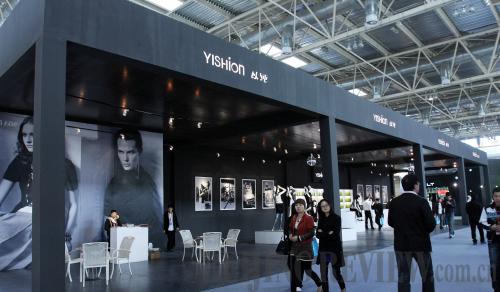|
 |
|
BIG-NAME BRAND: Yishion participates in the 17th China International Clothing & Accessories Fair in Beijing in 2009. The clothing line now has 3,000 outlets in 19 countries (XINHUA) |
Not many people knew the name of the man carrying the 2010 Asian Games torch as he ran through Dongguan, Guangdong Province, on October 17. He was no different than any other runner, but many of the young spectators watching the torch pass shared a common bond: They were probably wearing his clothing brand.
The torchbearer was Guo Donglin, founder of Dongguan Dongyue Garment Co. Ltd. and owner of the leisure apparel brand Yishion.
Guo built his garment empire from scratch 13 years ago and has now branched out into 19 countries with 3,000 outlets. In 2009 the 20,000-employee Yishion reported sales revenue of 8 billion yuan ($1.1 billion).
In June 2010, Yishion formed a 51:49 joint venture with a distribution firm in India to launch the brand in the world's second most populous country, with a presence in more than 100 outlets in two years.
Taking the distribution chain of Zara, the world's third largest apparel retailer, as an example, the low- and middle-end Yishion brand is also eyeing European and North American markets. With high hopes, Guo looks to compete in developing countries against Western brands, the same way H&M and Zara are doing in China.
The diligent one
Born in 1971 in Heyuan, Guangdong Province, Guo lived a life of poverty and despair. Meals consisted of porridge and brined vegetables, and rice and meat were luxuries reserved for festivals and special occasions.
As a middle school student, Guo would sit alone at lunch, eating as quickly as possible to avoid mockery from classmates over his meager meal. But it wasn't the poverty that Guo was afraid of, it was the glares his classmates gave him when someone's belongings went missing. He was assumed guilty because of his social standing.
With no one to turn to after these frequent humiliations, Guo often cried alone by a small river near the school. As tears ran down his face, he would tell himself to be stronger, to be better than his classmates and to take fate into his own hands.
Even with this strong spirit, forces outside his control seemed determined to challenge his will. After his family failed to manage his tuition, Guo was forced to drop out during his second year of high school. With his hopes of getting a proper education all but shattered, Guo turned his attention to business after seeing an opportunity to make money through lumbering work. Borrowing 4,000 yuan ($606) from relatives, Guo joined the lumber trade. But bad luck struck again, and in his first business venture Guo lost everything.
| 